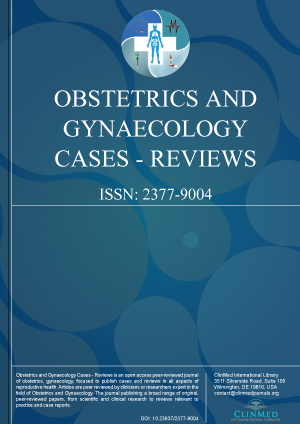Open Access DOI:10.23937/2377-9004/1410188
Modification of Staged Embolization-Hysterectomy Procedure for Placenta Accreta to Avoid Non-Target Embolisation of Ovaries
Catherine L Davis, Bishoy Hanna, John Keogh, Eisen Liang and Amir Hanna
Article Type: Case Series | First Published: December 21, 2020
Placenta accreta spectrum describes the abnormal adherence of the placenta to, into or beyond the myometrium of the uterus. Three women who were antenatally diagnosed with placenta accreta underwent a modified staged embolization- hysterectomy procedure consisting of; placement of prophylactic bilateral common iliac artery occlusion balloons, a classical caesarean section, surgical dissection of the ovaries from the uterus, embolization of the uterine arteries, followed by hysterectomy. The thre...
Open Access DOI:10.23937/2377-9004/1410187
A Pelvic Mass Masquerading as High Stage Malignancy - An Interesting Presentation of Psuedo-Meigs Syndrome
Cathy Monteith, PhD, Tamara Kalisse, Robert A Farrell, Yulia Shahabuddin and Thomas John D’Arcy, MD
Article Type: Case Report | First Published: December 21, 2020
The lifetime risk of developing an ovarian malignancy is reported to be 1.4%. Invasive epithelial ovarian cancers have the highest prevalence in women between 60-64 years while germ cell or borderline tumours pre-dominate in women under 40 years. We report the case of a 33-yearold nulliparous woman with a 7 kg leiomyoma, extensive endometriosis and several radiological features suggestive of a high stage ovarian malignancy. Meigs syndrome typically presents as a triad of ascites, pleural effusio...
Open Access DOI:10.23937/2377-9004/1410186
Trocar-Site Herniation (TSH) of the Small Bowel following Laparoscopy Despite Rectus Sheath Closure, Resulting in Subacute Bowel Obstruction in the Early Post-Operative Period: A Case Discussion and Review of Literature
Senadheera, DI, Jayasundara, DMCS and Jayawardane, IA
Article Type: Case Report and Literature Review | First Published: December 12, 2020
Laparoscopy is becoming the gold slandered of access to the abdomen and pelvis. However, it’s not without unique complications. Trocar site hernia is a rare but a serious complication which can cause diagnostic confusion, in the early post-operative period. It can be potentially life threatening with obstruction, strangulation, incarceration and finally perforation of the bowel, after a seemingly uncomplicated laparoscopy. First ever TSH, reported by “Fear in 1968”. Early studies described...
Open Access DOI:10.23937/2377-9004/1410185
Leiomyoma of the Vulva
Nagat Bettamer, Ream Langhe, Zahia Elghazal, Farag Ben Ali and Lamia Alkikhia
Article Type: Case Report | First Published: December 06, 2020
The authors present a rare case of vulval swelling in a 2-year period in a 35-year-old woman. The swelling was associated with mild vulval discomfort but no other symptoms. The tumour was removed surgically with no complications. Histopathology of the swelling confirmed vulval leiomyoma. Postoperative recovery was unremarkable and the woman was discharged on postoperative day 2. A 35-year-old patient presented to our department with a history of painless left vulval swelling of over a duration o...
Open Access DOI:10.23937/2377-9004/1410184
Ulipristal Acetate: Medical Management for Benign Metastasizing Leiomyoma?
Adina Schwartz, MD, Olivia Carpinello, MD and Alan DeCherney, MD
Article Type: Case Report | First Published: December 03, 2020
To describe the use of ulipristal acetate in an attempt to medically treat benign metastasizing leiomyoma (BML). Benign metastasizing leiomyoma (BML) is a rare disease characterized by smooth muscle tumors found outside of the uterus. Treatment options include surgery, embolization, and medical management. This case describes the use of ulipristal acetate in an attempt to medically manage an inoperable case of BML. A 40-year-old female presented with abdominal pain, urinary frequency, and decrea...
Open Access DOI:10.23937/2377-9004/1410183
Antenatal Management of Second Trimester Oligohydramnios and Evolving Abnormal Ultrasound Findings: Case Report
Daniel Roshan, MD, FACOG, FACS, Ellen Kolman, PA-C, Shira Plonka, MS CGC and Ilan Timor, MD, FACOG
Article Type: Case Report | First Published: December 03, 2020
Appropriate patient selection for prenatal intervention in the setting of abnormal antenatal ultrasound findings remains challenging. This case illustrates the course of a complicated pregnancy in a 35-year-old gravida 1 para 0 who presented to our Maternal-Fetal-Medicine clinic at 24.2 weeks gestation with fetal ascites, scalp edema, and oligohydramnios. Her first trimester ultrasound and genetic screening was normal. The patient was counseled that the observed findings carried a high chance fo...
Open Access DOI:10.23937/2377-9004/1410182
Opioid Consumption after Transversus Abdominis Plane Block in Abdominal Hysterectomy
Ashley S Moon, MD, Dorothy Wakefield, MS, Joann Petrini, PhD, MPH, Vaagn Andikyan, MD and Erin Panarelli, MD
Article Type: Original Research | First Published: November 19, 2020
Transversus abdominis plane (TAP) block is an important component of multimodal analgesia after abdominal hysterectomy to help with postoperative pain control. Our study evaluates 24-hour postoperative opioid consumption after TAP block in abdominal hysterectomy. Retrospective study of 174 women who underwent abdominal hysterectomy at a single institution. Statistical analyses compared demographic variables, compared opioid consumption and pain score distributions, assessed the association betwe...
Open Access DOI:10.23937/2377-9004/1410181
A Case Report of Spontaneous Pregnancy in a Mosaic Turner Syndrome Patient
Abdelrahman Yousif, Madeline Wheatley and Moustafa A Abuzeid
Article Type: Case Report | First Published: November 04, 2020
1 in every 2500 females is born with turner syndrome (TS), a result of chromosomal abnormalities of the X chromosome. A common symptom of this syndrome is infertility due to ovarian dysgenesis. This case report will detail a spontaneous pregnancy in a 22-year-old female Gravida 1 Para 0 (G1P0) patient with mosaic Turner syndrome. At 34 weeks 0 days, she presented for her prenatal appointment with a past medical history significant for mosaic Turner syndrome diagnosed in her teens after a diagnos...

